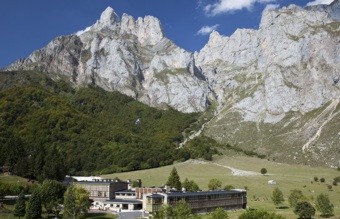
Fuente De, Cantabria, SpainFuente De is located in the region of Cantabria in northern Spain. One of the main draws to the area is the Picos de Europa mountains. Picos de Europe means literally the ‘Peaks of Europe’, and got their name because this was the first thing ships from the Americas saw as they approached Spain’s northern coast.  These dramatic steep, jagged peaks were formed over a period of 300 million years, with lakes and valleys forged by the glaciers that weaved their way through them. The mountains are extremely popular with walkers and mountaineers, however because of its proximity to the Atlantic and the Bay of Biscay, they are prone to experiencing sudden changes in weather with mists rolling in from nowhere. Obviously, this can make it rather hazardous at times, so if you wish to go hiking the Cares route is recommended, which begins from Poncebos and finishes in Cain.
These dramatic steep, jagged peaks were formed over a period of 300 million years, with lakes and valleys forged by the glaciers that weaved their way through them. The mountains are extremely popular with walkers and mountaineers, however because of its proximity to the Atlantic and the Bay of Biscay, they are prone to experiencing sudden changes in weather with mists rolling in from nowhere. Obviously, this can make it rather hazardous at times, so if you wish to go hiking the Cares route is recommended, which begins from Poncebos and finishes in Cain.
The Picos de Europa National Park was established in 1918 and covered almost 17,000 hectares. Today it covers over 64,000 hectares, with one of the main visitor centres in the Liebana valley at Sotama. For bird watchers this is an opportunity to spot some very rare breeds such as the highly endangered Cantabrian Capercaillie, the Griffon vulture, Golden eagle, and Black woodpecker. The Cantabrian brown bear can also be seen in the hilltops and woods surrounding the valleys, and occasionally the Iberian wolf is a visitor to the Park. For those who wish to explore the area’s more historical heritage there are some very interesting places to visit. First begin with the Monastery of Santo Toribio de Liebana. This Roman Catholic monastery was founded in the 8th century and was where the Monk Beatus of Liebana wrote his commentary on the Apocalypse. It has become an important pilgrimage centre, and one of the holiest Roman Catholic sites in Europe, because it possesses the left arm of the True Cross. This is the largest surviving piece of the cross upon which Jesus was crucified. It was brought to the monastery by Santo Toribio in the 7th century to protect it from capture by the Moors. Whenever the Saint's day falls on a Sunday, that year becomes a Holy year. This is when the Puerta del Perdon (Door of Pardon) is opened and pilgrims passing through the door are absolved of all sin. The charming 10th century Santa Maria Church set in hills near Lebena is also worth a visit. As is the Torre del Infantado in Potes. Home of the Marquis of Santillana, this rather stately tower with its grand balcony, battlements along the top, and tiny windows which are literally few and far between, is quite an intriguing structure. Potes is also famous for its Orujo Festival in the Autumn which revolves around the locally produced food and wine. Orujo is a distilled liqueur which has been produced in this region for many centuries and so popular is this event, thousands descend on Potes each year to take part. Hiking, mountain biking, horseback riding, and hang gliding are just a few activities available in the area, and there is no better place to base yourself while you are there than the Parador Fuente De (Hotel Rio Deva). Set at the foothills of the Picos, the hotel is right next to the cable car that takes visitors up to the Aliva viewpoint, where you can look down over stunning views of the Liebana Valley. A comfortable and very welcoming hotel, it is the perfect place to come back to at the end of the day. |